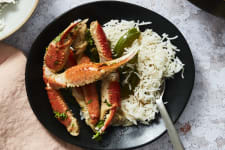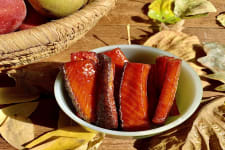Lunar New Year falls on Tuesday, February 1st this year — and we are eagerly (and hungrily!) counting down the days until this huge, global celebration of family and food. In anticipation of the Lunar New Year, I’d love to share a special Q&A with Crystal Lee, our Director of Data Science & Analytics. With grace and gusto, Crystal is the maestro behind the figures that help guide the Wild Alaskan ship as our own fish family grows into each new year.
As a second-generation Cantonese-American, seafood has always been an integral part of the food culture in Crystal’s family. After all, she grew up eating fish at least once or twice a week — pretty normal for a Cantonese family, she explained. And for Lunar New Year, the entire family typically gathers together to enjoy an epic feast centered around a whole, steamed fish. This steamed fish dish is infused with delicious flavors — and, more importantly, is steeped in deep meaning, symbolism, and intergenerational connection.
What does it mean to your family to celebrate the Lunar New Year?
Lunar New Year is the biggest and most important celebration in the year for Chinese people. It’s the time of year for all generations of your family to come together (physically) and to celebrate together. It’s similar to Thanksgiving in that you all go home and celebrate with your whole extended family.
Both of my parents were born in Hong Kong. They met taking English classes after work, and they decided to immigrate to the US after they got married in the 1980s to pursue computer hardware manufacturing. The rest of my extended family is still in Hong Kong, so Lunar New Year is usually my parents, myself and my brother.
How does fish fit into the Lunar New Year Celebration?
There are many traditional sayings for Lunar New Year to send your well wishes to others. Many of these sayings are celebrated with food, using words that rhyme with the saying itself.
One saying we often use is 年年有餘, which means, “May every year end with ample surplus,” pronounced “Nian nian you yu.” That last word “yu” rhymes with the word for ”fish,” and so it’s traditional to serve fish with your Lunar New Year meal. Traditionally, families celebrate by making a whole fish.
So what does fish symbolize during the Lunar New Year?
Referring back to the saying, the fish we serve signifies surplus — a wish that a family (or a business or a country) is doing well and in a healthy state, that they’ll have ample leftovers, wealth, food etc. for the year to come. Fish is very important to Cantonese people in particular because Hong Kong used to be a fishing village before it became a financial supercenter.
Sounds fortuitous! How do you prepare the fish?
For Lunar New Year, we usually steam it with a preparation that is simple so you can really enjoy the flavor of the fish. You place the fish on the steaming basket and cover it in garlic and ginger that’s been lightly fried in oil. Then you top that with soy sauce and let the whole thing steam. The steam keeps the texture moist, soft, and flaky. It’s amazing.
That gets served with vegetables on the side, and up to 10 other dishes, including sweets and fruits that are also symbolic of good fortune for the coming year.
Who taught you to prepare fish?
Learning to cook is passed down by shared experiences generation to generation — especially in Chinese culture. Recipes are generally not written down. My mom would say, “Just watch me do it until you know it.” If I asked her how much of a certain ingredient to add, she’d reply, “Just put enough.”
We do often still prepare a whole fish, steamed or pan-fried, but my mom also takes her Wild Alaskan Company box and uses those fillets to make steamed or pan-fried fish.
How have your traditions for Lunar New Year changed over the years?
My brother and I always fly to our parents' home to celebrate Lunar New Year together. But we haven’t been able to do so in the last two years due to Covid, so we’ve had to celebrate virtually, trading recipes over group text, video chats and sending each other pictures of our food. Since we can’t celebrate together, we’ve been asking my mom how to make the recipes on our own. It’s actually led to even more passing down of traditions in terms of making traditional food. We also video chat with my extended family in Hong Kong — it’s at least 15 people.
I love that we’re practicing our tradition as the second generation in this country, and actively working to understand the meaning of these traditions.
***
In case you’re feeling as inspired as I am to steam some fish next week, Crystal has shared a recipe with us that you can make with your favorite white fish fillet, adapted from her family’s own Lunar New Year recipe for steamed fish. It’s delicate and fragrant, made with ingredients that you can find anywhere, wherever you’re taking a piece of this Lunar New Year tradition into your own home.
Live Wild,
Monica
Pictured above: A festive photo montage of what Lunar New Year is like in the Lee household. Note the vase of delicate peach blossoms still on their slender branches, a traditional floral arrangement for the new year, and the ornate red and gold packets, which contain money and are customarily given by elders to family and friends along with the traditional well wishes for the year to come. And of course, a grand spread of whole, steamed fish under a mountain of ginger.






